The Structure of Gd3+-Doped Li2O and K2O Containing Aluminosilicate Glasses from Molecular Dynamics Simulations
Abstract
1. Introduction
2. Computational Details
3. Results and Discussion
3.1. General Structure
3.2. Structural Influence of the Network Modifier Ions
3.3. Local Environment around Gd3+ Ions
3.4. Correlation of Rare Earth Luminescence and Gd3+ Coordination
4. Conclusions
Author Contributions
Funding
Institutional Review Board Statement
Informed Consent Statement
Data Availability Statement
Conflicts of Interest
References
- Jiang, L.; Guo, X.; Li, X.; Li, L.; Zhang, G.; Yan, Y. Different K+–Na+ inter-diffusion kinetics between the air side and tin side of an ion-exchanged float aluminosilicate glass. Appl. Surf. Sci. 2013, 265, 889–894. [Google Scholar] [CrossRef]
- Mauro, J.C.; Tandia, A.; Vargheese, K.D.; Mauro, Y.Z.; Smedskjaer, M.M. Accelerating the Design of Functional Glasses through Modeling. Chem. Mater. 2016, 28, 4267–4277. [Google Scholar] [CrossRef]
- Wurth, R.; Muñoz, F.; Müller, M.; Rüssel, C. Crystal growth in a multicomponent lithia aluminosilicate glass. Mater. Chem. Phys. 2009, 116, 433–437. [Google Scholar] [CrossRef]
- Dittmer, M.; Rüssel, C. Colorless and high strength MgO/Al2O3/SiO2 glass–ceramic dental material using zirconia as nucleating agent. J. Biomed. Mater. Res. B 2012, 100B, 463–470. [Google Scholar] [CrossRef] [PubMed]
- Dittmer, M.; Yamamoto, C.F.; Bocker, C.; Rüssel, C. Crystallization and mechanical properties of MgO/Al2O3/SiO2/ZrO2 glass-ceramics with and without the addition of yttria. Solid State Sci. 2011, 13, 2146–2153. [Google Scholar] [CrossRef]
- Seidel, S.; Dittmer, M.; Höland, W.; Rüssel, C. High-strength, translucent glass-ceramics in the system MgO-ZnO-Al2O3-SiO2-ZrO2. J. Eur. Ceram. Soc. 2017, 37, 2685–2694. [Google Scholar] [CrossRef]
- Tiegel, M.; Hosseinabadi, R.; Kuhn, S.; Herrmann, A.; Rüssel, C. Young’s modulus, Vickers hardness and indentation fracture toughness of alumino silicate glasses. Ceram. Int. 2015, 41, 7267–7275. [Google Scholar] [CrossRef]
- Ehrt, D.; Vu, H.T.; Herrmann, A.; Völksch, G. Luminescent ZnO-Al2O3-SiO2 Glasses and Glass Ceramics. J. Adv. Mater. Res. 2008, 39–40, 231–236. [Google Scholar] [CrossRef]
- Körner, J.; Hein, J.; Tiegel, M.; Kuhn, S.; Buldt, J.; Yue, F.; Seifert, R.; Herrmann, A.; Rüssel, C.; Kaluza, M.C. Investigation of Yb3+-doped alumino-silicate glasses for high energy class diode pumped solid state lasers. In Proceedings of the High-Power, High-Energy, and High-Intensity Laser Technology II, SPIE, Prague, Czech Republic, 13–16 April 2015; SPIE: Bellingham, WA, USA, 2015; Volume 9513. [Google Scholar]
- Turki, R.; Zekri, M.; Herrmann, A.; Rüssel, C.; Maalej, R.; Damak, K. Optical properties of peralkaline aluminosilicate glasses doped with Sm3+. J. Alloys Compd. 2019, 806, 1339–1347. [Google Scholar] [CrossRef]
- Herrmann, A.; Tewelde, M.; Kuhn, S.; Tiegel, M.; Rüssel, C. The effect of glass composition on the luminescence properties of Sm3+ doped alumino silicate glasses. J. Non Cryst. Solids 2018, 502, 190–197. [Google Scholar] [CrossRef]
- Herrmann, A.; Kuhn, S.; Tiegel, M.; Rüssel, C.; Körner, J.; Klöpfel, D.; Hein, J.; Kaluza, M.C. Structure and fluorescence properties of ternary aluminosilicate glasses doped with samarium and europium. J. Mater. Chem. C 2014, 2, 4328–4337. [Google Scholar] [CrossRef]
- Herrmann, A.; Kuhn, S.; Tiegel, M.; Rüssel, C. Fluorescence properties of Eu3+-doped alumino silicate glasses. Opt. Mater. 2014, 37, 293–297. [Google Scholar] [CrossRef]
- Zekri, M.; Herrmann, A.; Turki, R.; Rüssel, C.; Maâlej, R.; Damak, K. Experimental and theoretical studies of Dy3+ doped alkaline earth aluminosilicate glasses. J. Lumin. 2019, 212, 354–360. [Google Scholar] [CrossRef]
- Assadi, A.; Herrmann, A.; Tewelde, M.; Damak, K.; Maalej, R.; Rüssel, C. Tb3+ as a probe for the molecular structure of mixed barium magnesium alumino silicate glasses. J. Lumin. 2018, 199, 384–390. [Google Scholar] [CrossRef]
- Assadi, A.; Herrmann, A.; Lachheb, R.; Damak, K.; Rüssel, C.; Maâlej, R. Experimental and theoretical spectroscopic study of erbium doped aluminosilicate glasses. J. Lumin. 2016, 176, 212–219. [Google Scholar] [CrossRef]
- Tiegel, M.; Herrmann, A.; Kuhn, S.; Rüssel, C.; Körner, J.; Klöpfel, D.; Seifert, R.; Hein, J.; Kaluza, M.C. Fluorescence and thermal stress properties of Yb3+-doped alumino silicate glasses for ultra high peak power laser applications. Laser Phys. Lett. 2014, 11, 115811. [Google Scholar] [CrossRef]
- Cormier, L. Glasses: Aluminosilicates. Encycl. Mater. Tech. Ceram. Glasses 2021, 2, 496–518. [Google Scholar]
- Stebbins, J.F.; Wu, J.; Thompson, L.M. Interactions between network cation coordination and non-bridging oxygen abundance in oxide glasses and melts: Insights from NMR spectroscopy. Chem. Geol. 2013, 346, 34–46. [Google Scholar] [CrossRef]
- Neuville, D.R.; Cormier, L.; Montouillout, V.; Florian, P.; Millot, F.; Rifflet, J.-C.; Massiot, D. Structure of Mg-and Mg/Ca aluminosilicate glasses: 27Al NMR and Raman spectroscopy investigations. Am. Min. 2008, 93, 1721–1731. [Google Scholar] [CrossRef]
- Stebbins, J.F.; Xu, Z. NMR evidence for excess non-bridging oxygen in an aluminosilicate glass. Nature 1997, 390, 60–62. [Google Scholar] [CrossRef]
- Toplis, M.J.; Dingwell, D.B.; Lenci, T. Peraluminous viscosity maxima in Na2O Al2O3 SiO2 liquids: The role of triclusters in tectosilicate melts. Geochim. Cosmochim. Acta 1997, 61, 2605–2612. [Google Scholar] [CrossRef]
- Iuga, D.; Morais, C.; Gan, Z.; Neuville, D.R.; Cormier, L.; Massiot, D. NMR heteronuclear correlation between quadrupolar nuclei in solids. J. Am. Chem. Soc. 2005, 127, 11540–11541. [Google Scholar] [CrossRef]
- Lodesani, F.; Menziani, M.C.; Hijiya, H.; Takato, Y.; Urata, S.; Pedone, A. Structural origins of the mixed alkali effect in alkali aluminosilicate glasses: Molecular dynamics study and its assessment. Sci. Rep. 2020, 10, 1–18. [Google Scholar] [CrossRef]
- Atila, A.; Ghardi, E.M.; Ouaskit, S.; Hasnaoui, A. Atomistic insights into the impact of charge balancing cations on the structure and properties of aluminosilicate glasses. Phys. Rev. B 2019, 100, 144109. [Google Scholar] [CrossRef]
- Zekri, M.; Erlebach, A.; Herrmann, A.; Damak, K.; Rüssel, C.; Sierka, M.; Maâlej, R. Structure Prediction of Rare Earth Doped BaO and MgO Containing Aluminosilicate Glasses–the Model Case of Gd2O3. Materials 2018, 11, 1790. [Google Scholar] [CrossRef] [PubMed]
- Charpentier, T.; Okhotnikov, K.; Novikov, A.N.; Hennet, L.; Fischer, H.E.; Neuville, D.R.; Florian, P. Structure of strontium aluminosilicate glasses from molecular dynamics simulation, neutron diffraction, and nuclear magnetic resonance studies. J. Phys. Chem. B 2018, 122, 9567–9583. [Google Scholar] [CrossRef] [PubMed]
- Xiang, Y.; Du, J.; Smedskjaer, M.M.; Mauro, J.C. Structure and properties of sodium aluminosilicate glasses from molecular dynamics simulations. J. Chem. Phys. 2013, 139, 044507. [Google Scholar] [CrossRef]
- Ganster, P.; Benoit, M.; Kob, W.; Delaye, J.-M. Structural properties of a calcium aluminosilicate glass from molecular-dynamics simulations: A finite size effects study. J. Chem. Phys. 2004, 120, 10172–10181. [Google Scholar] [CrossRef]
- Ganisetti, S.; Gaddam, A.; Kumar, R.; Balaji, S.; Mather, G.C.; Pascual, M.J.; Fabian, M.; Siegel, R.; Senker, J.; Kharton, V.V. Elucidating the formation of Al–NBO bonds, Al–O–Al linkages and clusters in alkaline-earth aluminosilicate glasses based on molecular dynamics simulations. Phys. Chem. Chem. Phys. 2019, 21, 23966–23977. [Google Scholar] [CrossRef]
- Greaves, G.N. EXAFS and the structure of glass. J. Non Cryst. Solids 1985, 71, 203–217. [Google Scholar] [CrossRef]
- Greaves, G.; Fontaine, A.; Lagarde, P.; Raoux, D.; Gurman, S. Local structure of silicate glasses. Nature 1981, 293, 611–616. [Google Scholar] [CrossRef]
- Kelly, J., III; Cordaro, J.; Tomozawa, M. Correlation effects on alkali ion diffusion in binary alkali oxide glasses. J. Non Cryst. Solids 1980, 41, 47–55. [Google Scholar] [CrossRef]
- Plimpton, S. Fast Parallel Algorithms for Short-Range Molecular Dynamics. J. Comput. Phys. 1995, 117, 1–19. [Google Scholar] [CrossRef]
- Pedone, A.; Malavasi, G.; Menziani, M.C.; Cormack, A.N.; Segre, U. A new self-consistent empirical interatomic potential model for oxides, silicates, and silica-based glasses. J. Phys. Chem. B 2006, 110, 11780–11795. [Google Scholar] [CrossRef] [PubMed]
- Hockney, R.W.; Eastwood, J.W. Computer Simulation Using Particles; CRC Press: Boca Raton, FL, USA, 1988. [Google Scholar]
- Kokou, L.; Du, J. Rare earth ion clustering behavior in europium doped silicate glasses: Simulation size and glass structure effect. J. Non Cryst. Solids 2012, 358, 3408–3417. [Google Scholar] [CrossRef]
- Heuer, A. Exploring the potential energy landscape of glass-forming systems: From inherent structures via metabasins to macroscopic transport. J. Phys. Condens. Matter 2008, 20, 373101. [Google Scholar] [CrossRef]
- Debenedetti, P.G.; Stillinger, F.H. Supercooled liquids and the glass transition. Nature 2001, 410, 259–267. [Google Scholar] [CrossRef] [PubMed]
- Sciortino, F.; Kob, W.; Tartaglia, P. Inherent structure entropy of supercooled liquids. Phys. Rev. Lett. 1999, 83, 3214. [Google Scholar] [CrossRef]
- Shinoda, W.; Shiga, M.; Mikami, M. Rapid estimation of elastic constants by molecular dynamics simulation under constant stress. Phys. Rev. B 2004, 69, 134103. [Google Scholar] [CrossRef]
- Nosé, S. A unified formulation of the constant temperature molecular dynamics methods. J. Chem. Phys. 1984, 81, 511–519. [Google Scholar] [CrossRef]
- Haynes, W.M.; Lide, D.R. CRC Handbook of Chemistry and Physics: A Ready-Reference Book of Chemical and Physical Data, 91st ed.; CRC Press: Boca Raton, FL, USA, 2010. [Google Scholar]
- Du, J.; Cormack, A. The structure of erbium doped sodium silicate glasses. J. Non Cryst. Solids 2005, 351, 2263–2276. [Google Scholar] [CrossRef]
- Bardez, I.; Caurant, D.; Loiseau, P.; Baffier, N.; Dussossoy, J.L.; Gervais, C.; Ribot, F.; Neuville, D.R. Structural characterisation of rare earth rich glasses for nuclear waste immobilisation. Phys. Chem. Glasses 2005, 46, 320–329. [Google Scholar] [CrossRef]
- Pechenik, A.; Whitmore, D.; Susman, S.; Ratner, M.A. Transport in glassy fast-ion conductors: A stud of LiAlSiO4 glass. J. Non Cryst. Solids 1988, 101, 54–64. [Google Scholar] [CrossRef]
- Lee, S.K.; Stebbins, J.F. The degree of aluminum avoidance in aluminosilicate glasses. Am. Min. 1999, 84, 937–945. [Google Scholar] [CrossRef]
- Merzbacher, C.I.; Sherriff, B.L.; Hartman, J.S.; White, W.B. A high-resolution 29Si and 27Al NMR study of alkaline earth aluminosilicate glasses. J. Non Cryst. Solids 1990, 124, 194–206. [Google Scholar] [CrossRef]
- Thompson, L.M.; Stebbins, J.F. Non-bridging oxygen and high-coordinated aluminum in metaluminous and peraluminous calcium and potassium aluminosilicate glasses: High-resolution 17O and 27Al MAS NMR results. Am. Min. 2011, 96, 841–853. [Google Scholar] [CrossRef]
- Stebbins, J.F.; Dubinsky, E.V.; Kanehashi, K.; Kelsey, K.E. Temperature effects on non-bridging oxygen and aluminum coordination number in calcium aluminosilicate glasses and melts. Geochim. Cosmochim. Acta 2008, 72, 910–925. [Google Scholar] [CrossRef]
- Sadat, M.R.; Bringuier, S.; Muralidharan, K.; Runge, K.; Asaduzzaman, A.; Zhang, L. An atomistic characterization of the interplay between composition, structure and mechanical properties of amorphous geopolymer binders. J. Non Cryst. Solids 2016, 434, 53–61. [Google Scholar] [CrossRef]
- Smedskjaer, M.M.; Youngman, R.E.; Mauro, J.C. Impact of ZnO on the structure and properties of sodium aluminosilicate glasses: Comparison with alkaline earth oxides. J. Non Cryst. Solids 2013, 381, 58–64. [Google Scholar] [CrossRef]
- Ren, M.; Cheng, J.Y.; Jaccani, S.P.; Kapoor, S.; Youngman, R.E.; Huang, L.; Du, J.; Goel, A. Composition–structure–property relationships in alkali aluminosilicate glasses: A combined experimental–computational approach towards designing functional glasses. J. Non Cryst. Solids 2019, 505, 144–153. [Google Scholar] [CrossRef]
- Le Roux, S.; Jund, P. Ring statistics analysis of topological networks: New approach and application to amorphous GeS2 and SiO2 systems. Comput. Mater. Sci. 2010, 49, 70–83. [Google Scholar] [CrossRef]
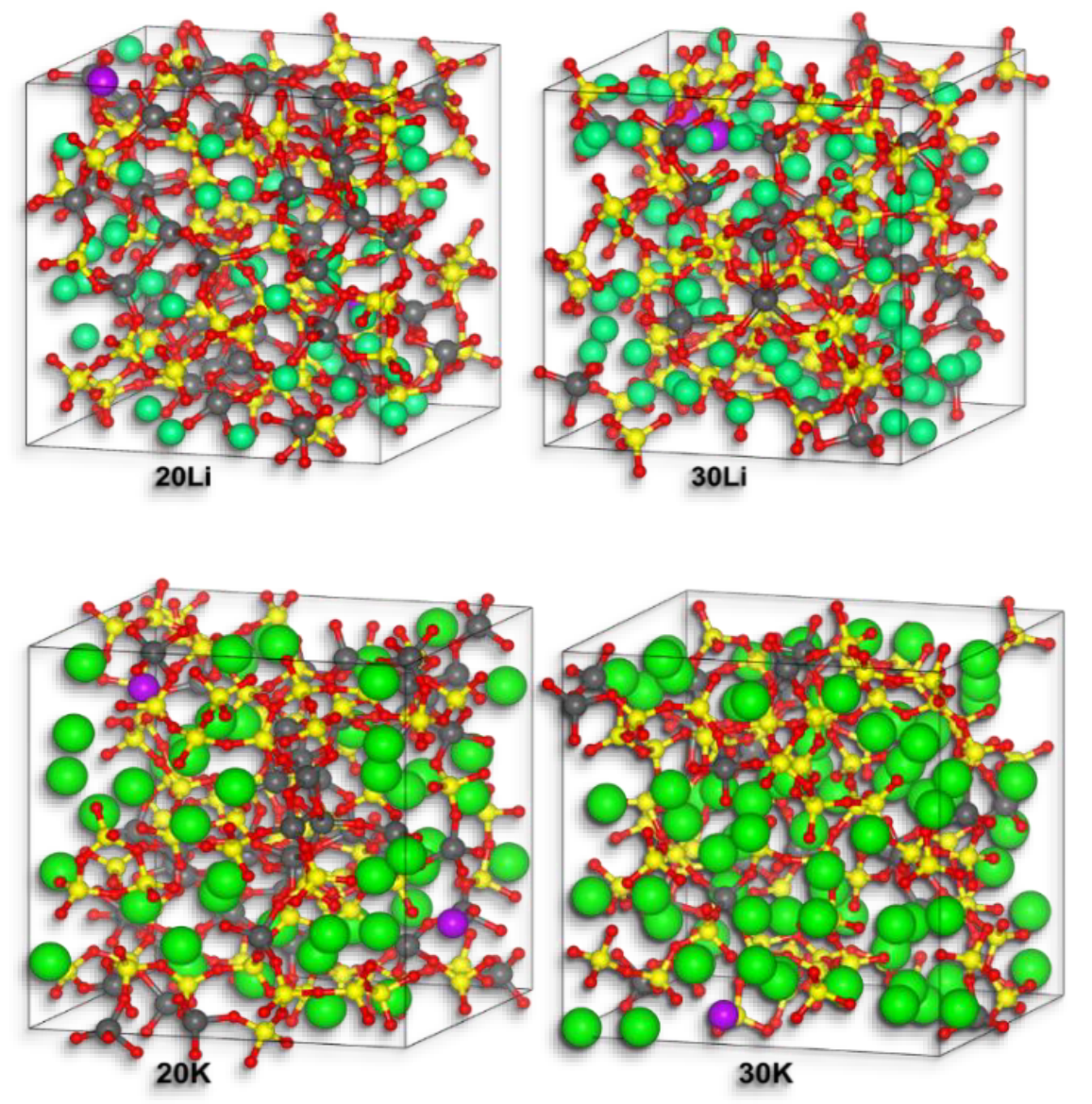
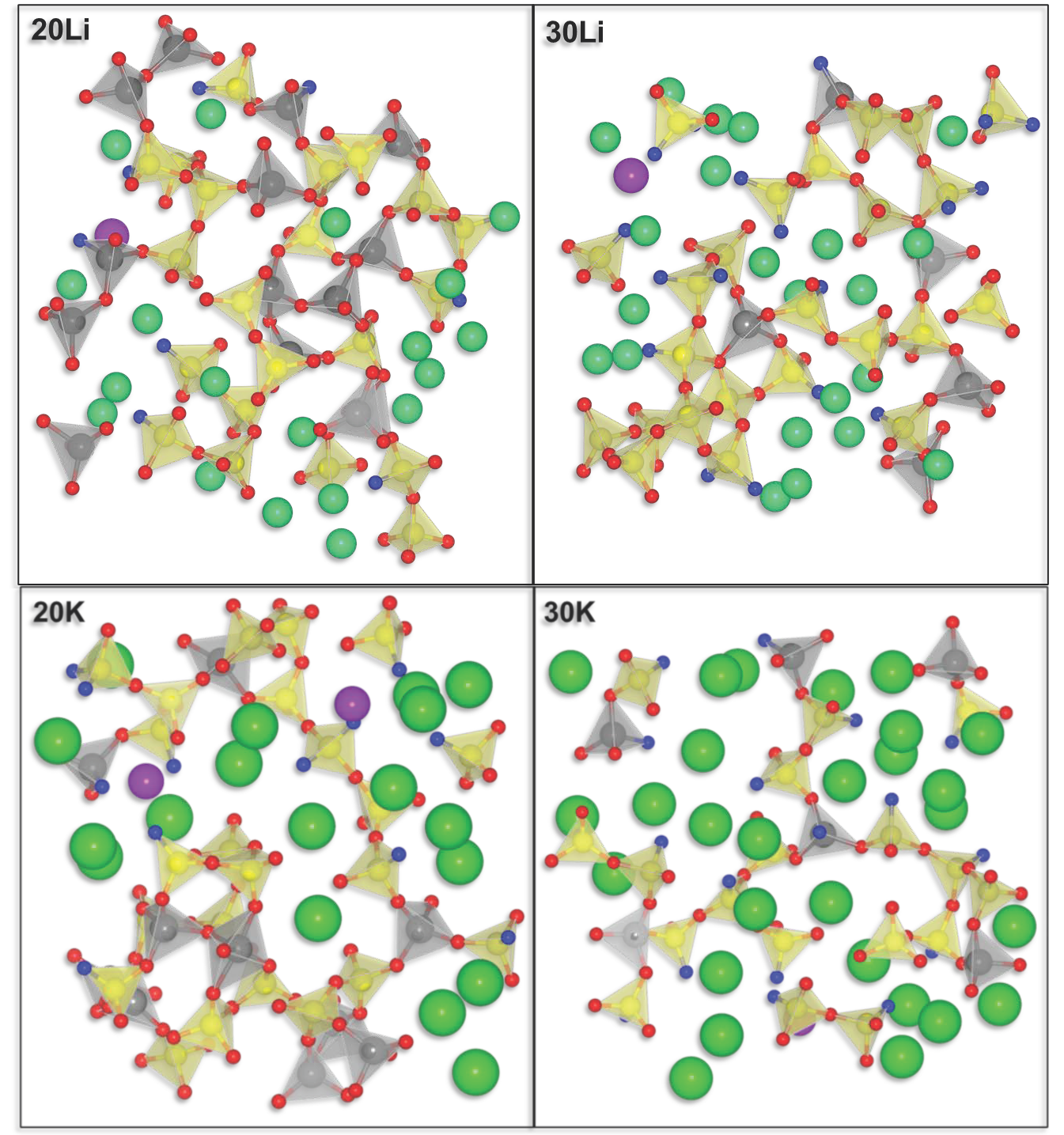
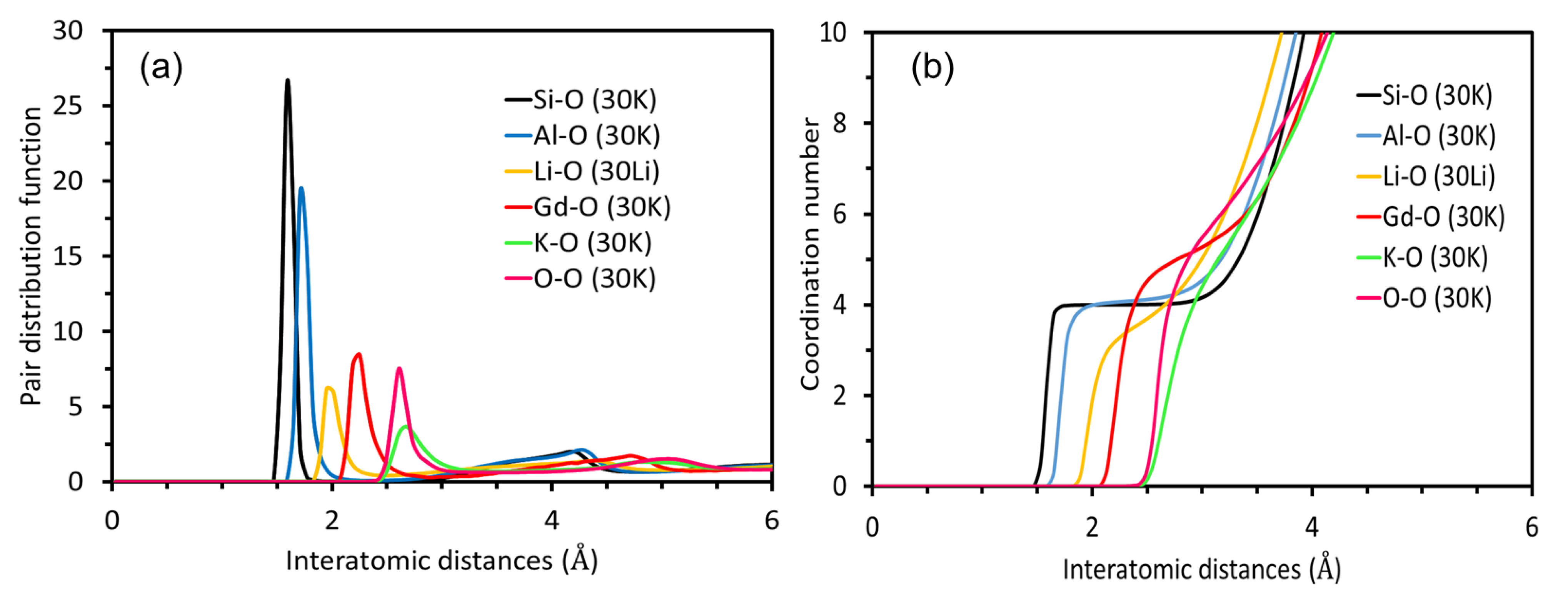
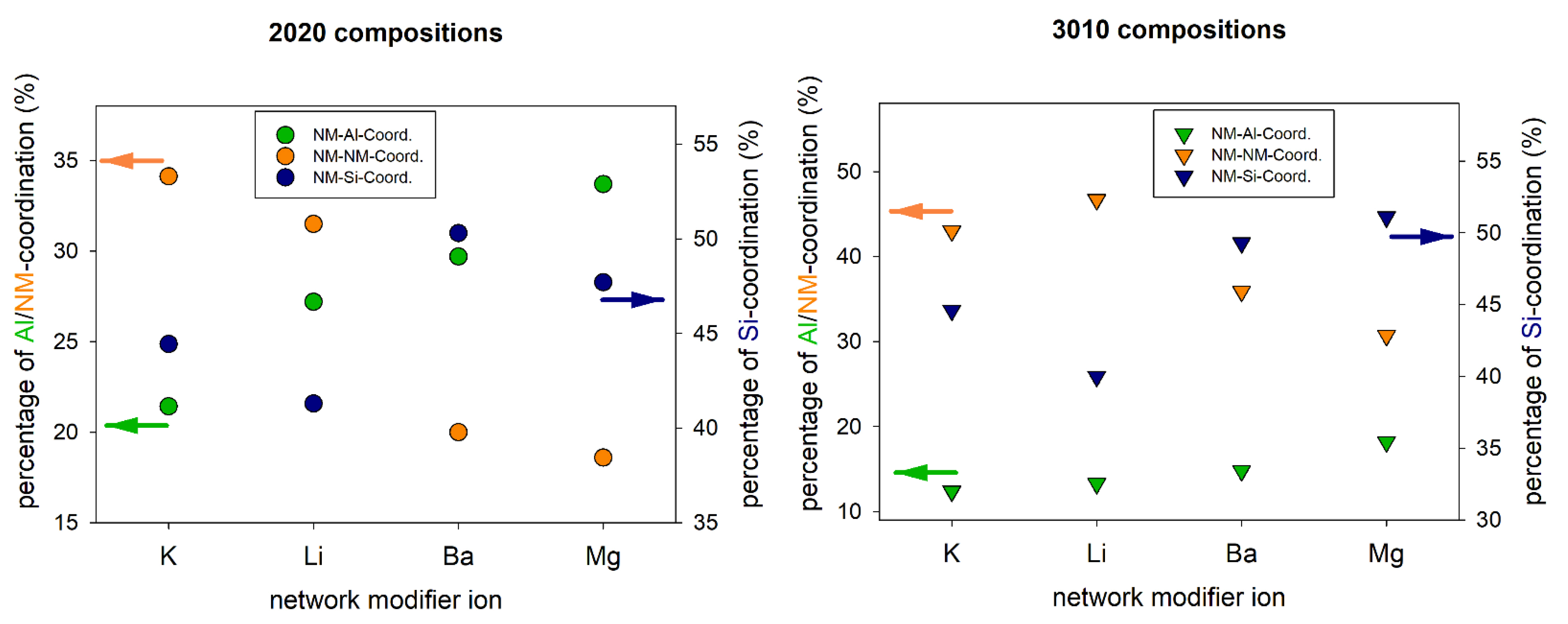



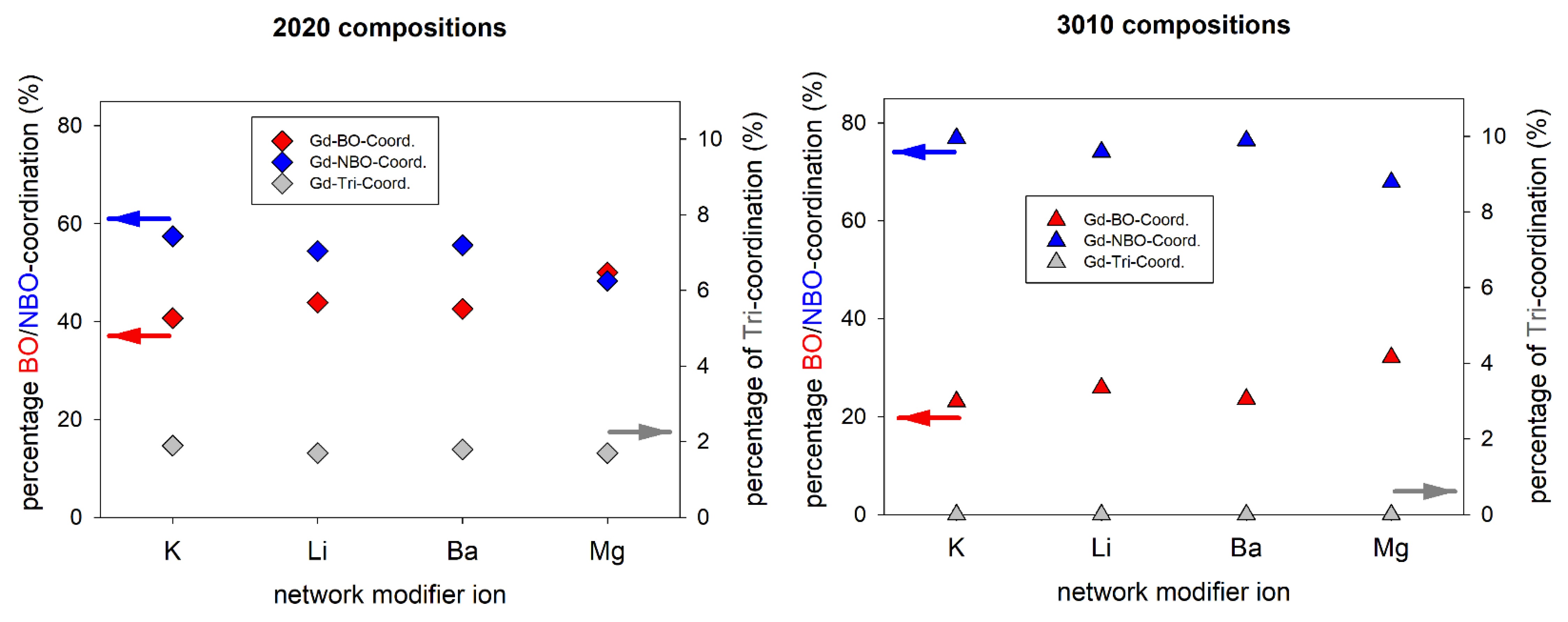
| Pair | Dij (eV) | aij (Å−1) | r0 (Å) | Cij (eV Å12) |
|---|---|---|---|---|
| Li0.6–O−1.2 | 0.001114 | 3.429506 | 2.681360 | 1.0 |
| K0.6–O−1.2 | 0.011612 | 2.062605 | 3.305308 | 5.0 |
| Si2.4–O−1.2 | 0.340554 | 2.006700 | 2.100000 | 1.0 |
| Al1.8–O−1.2 | 0.361581 | 1.900442 | 2.164818 | 0.9 |
| Gd1.8–O−1.2 | 0.000132 | 2.013000 | 4.351589 | 3.0 |
| O−1.2–O−1.2 | 0.042395 | 1.379316 | 3.618701 | 22.0 |
| Chemical Composition [mol%] | |||||
|---|---|---|---|---|---|
| Model | Unit Cell | NM2O | Al2O3 | SiO2 | Gd2O3 |
| 20Li | Gd2Li50Al50Si75O253 | 19.8 | 19.8 | 59.5 | 0.9 |
| 30Li | Gd2Li75Al25Si75O228 | 29.8 | 9.9 | 59.5 | 0.8 |
| 20K | Gd2K50Al50Si75O253 | 19.8 | 19.8 | 59.5 | 0.9 |
| 30K | Gd2K75Al25Si75O228 | 29.8 | 9.9 | 59.5 | 0.8 |
| CN Fraction (Distance) | 20Li | 30Li | 20K | 30K |
|---|---|---|---|---|
| NM-O | 3.7 | 3.7 | 6.6 | 6.4 |
| (2.01 Å) | (1.95 Å) | (2.67 Å) | (2.67 Å) | |
| NM-NM | 2.9 | 4.9 | 4.3 | 5.2 |
| 31.5% | 46.7% | 34.1% | 43.0% | |
| (2.61 Å) | (2.61 Å) | (3.39 Å) | (3.21 Å) | |
| NM-Al | 2.5 | 1.4 | 2.7 | 1.5 |
| 27.2% | 13.3% | 21.4% | 12.4% | |
| (3.03 Å) | (3.09 Å) | (3.54 Å) | (3.39 Å) | |
| NM-Si | 3.8 | 4.2 | 5.6 | 5.4 |
| 41.3% | 40.0% | 44.4% | 44.6% | |
| (3.15 Å) | (3.0 9Å) | (3.39 Å) | (3.45 Å) | |
| ΣCN | 9.2 | 10.5 | 12.6 | 12.1 |
| CN Fraction | 20Li | 30Li | 20K | 30K |
|---|---|---|---|---|
| NM-NBO | 1.2 | 1.9 | 1.2 | 2.0 |
| 32.4% | 51.4% | 18.2% | 31.2% | |
| NM-BO | 2.5 | 1.7 | 5 | 4.3 |
| 67.6% | 45.9% | 75.7% | 67.2% | |
| NM-Tri | 0.0 | 0.1 | 0.4 | 0.1 |
| 0.0% | 2.7% | 6.1% | 1.6% |
| [AlOx] Fractions | 20Li | 30Li | 20K | 30K |
|---|---|---|---|---|
| [AlO3] | 0.7% | 0.3% | 1.1% | 0.8% |
| [AlO4]− | 78.9% | 81.0% | 82.8% | 91.0% |
| [AlO5]2− | 18.9% | 17.5% | 15.0% | 7.9% |
| [AlO6]3− | 1.5% | 1.2% | 1.1% | 0.3% |
| Qn Fractions | 20Li | 30Li | 20K | 30K |
|---|---|---|---|---|
| n = 0 | 0.0% | 0.1% | 0.0% | 0.1% |
| n = 1 | 0.1% | 1.4% | 0.4% | 2.4% |
| n = 2 | 3.0% | 12.4% | 5.0% | 14.4% |
| n = 3 | 26.0% | 41.5% | 28.0% | 40.6% |
| n = 4 | 70.9% | 44.6% | 66.6% | 42.5% |
| CN Fraction (Distance) | 20Li | 30Li | 20K | 30K |
|---|---|---|---|---|
| Gd-O | 5.7 | 5.8 | 5.4 | 5.2 |
| (2.25 Å) | (2.25 Å) | (2.19 Å) | (2.25 Å) | |
| Gd-Al | 2.8 | 1.7 | 2.9 | 1.4 |
| 24.8% | 13.2% | 25.3% | 10.7% | |
| (3.57 Å) | (3.51 Å) | (3.51 Å) | (3.63 Å) | |
| Gd-Si | 4.6 | 5.2 | 4.0 | 4.5 |
| 40.7% | 40.3% | 34.9% | 34.3% | |
| (3.57 Å) | (3.57 Å) | (3.57 Å) | (3.63 Å) | |
| Gd-NM | 3.8 | 5.9 | 4.5 | 7.15 |
| 33.7% | 45.7% | 39.3% | 54.5% | |
| (3.15 Å) | (3.09 Å) | (3.81 Å) | (3.75 Å) | |
| Gd-Gd | 0.09 | 0.10 | 0.06 | 0.07 |
| 0.8% | 0.8% | 0.5% | 0.5% | |
| (4.02 Å) | (3.9 Å) | (3.78 Å) | (4.14 Å) | |
| Σ CN | 11.29 | 12.90 | 11.46 | 13.12 |
| CN Fraction | 20Li | 30Li | 20K | 30K |
|---|---|---|---|---|
| Gd-NBO | 3.1 | 4.3 | 3.1 | 4.0 |
| 54.4% | 74.1% | 57.4% | 76.9% | |
| Gd-BO | 2.5 | 1.5 | 2.2 | 1.2 |
| 43.9% | 25.9% | 40.7% | 23.1% | |
| Gd-Tri | 0.1 | 0.0 | 0.1 | 0.0 |
| 1.7% | 0.0% | 1.9% | 0.0% |
Publisher’s Note: MDPI stays neutral with regard to jurisdictional claims in published maps and institutional affiliations. |
© 2021 by the authors. Licensee MDPI, Basel, Switzerland. This article is an open access article distributed under the terms and conditions of the Creative Commons Attribution (CC BY) license (https://creativecommons.org/licenses/by/4.0/).
Share and Cite
Zekri, M.; Herrmann, A.; Erlebach, A.; Damak, K.; Rüssel, C.; Sierka, M.; Maâlej, R. The Structure of Gd3+-Doped Li2O and K2O Containing Aluminosilicate Glasses from Molecular Dynamics Simulations. Materials 2021, 14, 3265. https://doi.org/10.3390/ma14123265
Zekri M, Herrmann A, Erlebach A, Damak K, Rüssel C, Sierka M, Maâlej R. The Structure of Gd3+-Doped Li2O and K2O Containing Aluminosilicate Glasses from Molecular Dynamics Simulations. Materials. 2021; 14(12):3265. https://doi.org/10.3390/ma14123265
Chicago/Turabian StyleZekri, Mohamed, Andreas Herrmann, Andreas Erlebach, Kamel Damak, Christian Rüssel, Marek Sierka, and Ramzi Maâlej. 2021. "The Structure of Gd3+-Doped Li2O and K2O Containing Aluminosilicate Glasses from Molecular Dynamics Simulations" Materials 14, no. 12: 3265. https://doi.org/10.3390/ma14123265
APA StyleZekri, M., Herrmann, A., Erlebach, A., Damak, K., Rüssel, C., Sierka, M., & Maâlej, R. (2021). The Structure of Gd3+-Doped Li2O and K2O Containing Aluminosilicate Glasses from Molecular Dynamics Simulations. Materials, 14(12), 3265. https://doi.org/10.3390/ma14123265











